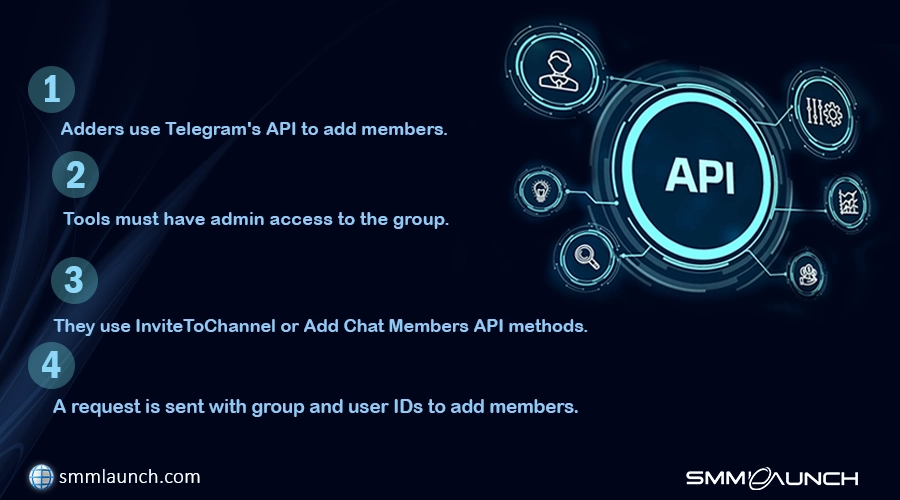
The magic of Telegram Group Member Adders
Today’s increasingly digital world has made social media platforms like Telegram much more than just messaging apps, but rather, they are powerhouses for building communities, engagement tools, and business promotion ladders. Therefore, many people seek to increase the number of members in their Telegram groups promptly and effectively. One of the solutions that comes to mind is Telegram group member adder.
Table of Contents
What is a Telegram group member adder?
Telegram group member adders are tools or services which are automated to carry out the adding of members to Telegram groups. These adders can range from simple to complex bots to those software applications that use the API of Telegram to add members in a bulk.
These tools are operating by extracting your Id or phone numbers from public groups or databases and adding them to your group. The goal? Increasing you group’s size and engagement as soon as possible and within the shortest time.
Types of Member Adders
Bots:
Bots are autonomous computer programs that are specifically designed for Telegram to do a variety of things such as adding people to different groups according to a given set of criteria.
Web-Based Tools:
Online platforms that provide interfaces for users to manage and add members without the need for programming knowledge.
APIs:
The Telegram API provides developers with the possibility to create custom solutions for managing group memberships programmatically thus allowing them to add users, send messages and automate various group management tasks.
How Telegram group member adder find members?
One of the many ways of increasing members in a Telegram group is to pull their personal data from a variety of sources. The data we can retrieve from users is their user ID, which is the simplest field. Alternatively, data like phone numbers, usernames, display names, and profile pictures, when available, would be the most complex types of data we can get from this process.
Extracting User Data from Telegram Groups or Channels
The primary method would be to extract the user IDs directly from Telegram groups or channels, especially from those that have a target audience similar to the one you are in search of.
Accessing the Target Group or Channel:
The extraction tool (bot or a custom script) can either join or access a public group or channel. It is mainly utilized for public groups, as their member lists are frequently disclosed.
Scraping User Data:
Once the tool is inside the group, it first scans the members' list and then begins extracting the information of users. The underlying reason is here is to gather the user IDs (the distinct figure that is assigned per each Telegram account.)
Other data that the Telegram group member adder can get includes:
Usernames: Public Telegram usernames.
Display Names: The names users choose to show publicly.
Profile Pictures: In some cases, profile pictures might be scraped.
This data is mainly used for creating fake accounts.
Creating a List of Extracted Users:
The tool or bot saves a list of all the retrieved data of users and usernames after scraping. Such lists may contain hundreds to thousands of user IDs, and these lists can also be targeted. Additionally, anti-spam algorithms can flag the activity as spam if the bot adds many users in a short time.

Extracting Phone Numbers from External Sources
Tools, besides extracting user Ids from Telegram, may focus on getting phone numbers from different websites, databases, or social platforms. These phone numbers are used to add users to Telegram groups.
Sources for Extracting Phone Numbers
Public Databases and Websites:
Tools can scrape the phone numbers from publicly available sources, such as business directories, forums, or any website, where people have published their contact information.
Purchased Databases:
Marketers or companies are able to purchase phone number databases from other sellers. The lists are made up of numbers that result from marketing programs, online sign-ups or email subscription.
Social Media Scraping:
In some medias like LinkedIn or public profiles of people’s Facebook, users might publish their phone numbers to the public, and the tools can then scrape that information and use it later on.
Other Sources:
Phone numbers can also be harvested from e-commerce websites, job boards, or online forums where people explicitly share their contact information with the purpose of networking or inquiring about sales or services.
Issues with Phone Number-Based Adding
Privacy Violations:
A lot of users might get the feeling of their privacy being violated when they are included in the group without their consent.
Telegram Spam Detection:
Users can be bulk added through phone numbers which can trigger the anti-spam filters in Telegram and this may lead to the suspension of accounts and the flagging of groups.
High Dropout Rate:
People are added to the group through mobile numbers, and if they get in without knowing or agreeing with the rest of the group, they tend to leave the group.
Creating Fake Accounts Using Virtual Numbers
A third strategy for including users is creating fake Telegram accounts by means of virtual or temporary phone numbers and then adding these accounts to groups.

How Fake Accounts Are Created
Virtual Phone Numbers:
Bots utilize virtual or temp phone numbers (often obtained from online services) to register a large number of fake telegram accounts. Most of these accounts created via automated systems to bypass Telegram SMS verification.
Generating Fake Profiles:
As soon as the accounts are created, the bots allocate to each of them a randomized username, profile picture, and a minimal profile information.
Proxies & VPNs:
In order to remain undetected, these bots employ proxy servers or VPNs to open multiple accounts without initiating the security mechanisms of Telegram.
Using Fake Accounts to Boost Group Size
Bulk Adding:
When the fake accounts are created, the Telegram groups are then filled with them in bulk to increase the number of members artificially.
Simulating Activity (Optional):
Some bots also pretend to be real accounts by simply doing some activities like viewing posts or making generic comments. However, this interaction is superficial and is not real.
Risks of Using Fake Accounts
Lack of Engagement:
Fake account never engage with the group’s content, thus the group might have the largest number of members, but there is no meaningful interaction.
Telegram Bans:
Telegram is constantly developing its algorithms to catch fake accounts. The fake ones can get banned if they are found out, and the group may also be fined or even suspended.
Damaged Credibility:
Genuine people are sometimes able to figure out the fact that the group is crowded by fake members, which may have an impact on the credibility of either your group or your brand.
How do Telegram group member adders add members to groups?
Telegram group member adders use several approaches to add members to groups, We will explore some of these methods.
Direct Adding via Telegram API
The Telegram’s API is the most common method the Telegram group member adder to use, which allows bots or other tools to interact directly with the Telegram servers and then add users to groups. Here’s how it works:
Accessing the Group
First, the tool or bot is given access to the group where members will be added. This means that the bot or tool must be an admin of the group or should be provided with required permissions.
Using API Methods
InviteToChannel or AddChatMembers: These two are the API methods that bots utilize to add members to a group. Here’s how these commands work:
- The bot or tool sends a request to Telegram's servers using the group’s unique identifier (chat_id) and a list of user IDs or phone numbers (user_id_list).
- Telegram servers handle the request, adding the specified users to the group.

Process Flow
- Send API Request: A request is issued to Telegram’s API using a command to append the extracted members (either by user IDs or phone numbers).
- Server Processing: Telegram processes the request. If the user’s privacy settings permit, they are automatically added to the group.
- Response: The bot or tool gets a success or failure message from Telegram, which signifies either the user was added successfully or some error (privacy restrictions or rate limits) occurred.
What might be confusing is that a username is different from a user ID:
Username: Optional and publicly visible (@paul_doe448).
User ID: Unique number assigned to every Telegram user (123456789), which isn’t immediately visible but is essential for interaction through the API.
Inviting Members Using Invitation Links
If privacy settings forbid the direct addition of a user (for example, when users have settings that block auto-adding), the next option is to send group invitation links. Here’s how that works:
• Generating Invitation Links: The bot or tool sets up invitation links for the group.
• Sending Invitations: Through the use of either the API or the automatic messaging systems, the bot sends these invitation links to users, usually via private messages or through other communication channels like SMS, email, and other Telegram groups.
The users by their choice can either accept or decline the invitation. This approach is more friendlier to the user but has lower effectiveness since users have to join to the group manually.

Virtual Numbers and Fake Accounts
In some cases, Telegram member adders use virtual numbers or fake accounts to increase group membership. This process involves creating temporary or fake accounts with virtual phone numbers, which are then used to populate the group.
- Creating Fake Accounts: Using virtual phone numbers from online services, bots can create multiple Telegram accounts. These accounts are then added to the group to artificially inflate membership numbers.
- Risks: This method carries significant risks as Telegram actively monitors and bans fake accounts. If Telegram identifies a large number of fake members in a group, both the fake accounts and the group can be suspended or banned.
How a telegram group member adder bypasses the telegram anti-spam algorithms
A telegram group member adder can use several techniques to make the added members look more “natural” so that the anti-spam algorithms of Telegram do not detect them.
Gradual Adding of Members
Through using random intervals and pacing, The Telegram group member adder simulates organic group growth, which makes it less likely to set off the anti-spam filters of Telegram.
Using Multiple Accounts
Through the use of proxies or VPNs, the activity can be made to appear as though it’s coming from multiple unrelated users, thus enhancing security.
Clever Targeting
Connecting users with groups that share common interest makes the additions look more organic.
Avoiding Bots or Fake Accounts
Employing old, real accounts rather than new or bot-only accounts helps to reduce the likelihood of being classified as spam.
Mimicking Human Behavior
Bots act out human-like actions like dealing with content to look like a real human and not to be caught.
Breaking up Activities
Changing tasks and taking breaks in doing things prevents the repetition of the same moves that could lead to spam filter detection.

Let’s Build Your Community the Right Way!
To wrap it up, even if the “Telegram group member adder” appears to be a magical way of increasing Telegram Group membership, one should be aware that it often comes with great dangers, which include being banned from Telegram for policy violations. In addition, a method such as this can take a lot of time and effort. On the other hand, SMMLaunch provides social media marketing services through a safer way as well as a more efficient alternative.
By our experience and affordable prices, we are able to give people real, premium accounts and thus, true member interaction happens without the risks associated with the methods mentioned above. When you opt for SMMLauch, you can build your Telegram group in a more effective manner and compliant with Telegram regulations.